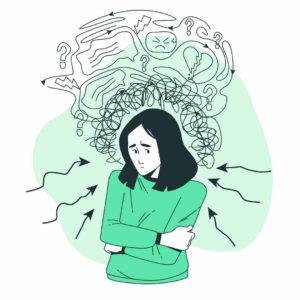CATEGORIES
#Gen Z #Health and Wellness #Well-BeingOverview:
- Mental health issues account for 19% of the total share of diseases among adolescents and young adults,
- Common signs involve stress, anxiety, and severe forms of phobias.
- Incorporating healthy habits like mindfulness and SEL can effectively help in managing one’s mental health issues.
All around the globe, a common theme that persists throughout any population is the share of students. One can find students everywhere, pursuing varying degrees of education and attaining differing skills. With education, comes the pressure among millions of students. This pressure often hides behind the silver lining of academic excellence and rigid stereotypes. This pressure is good, it motivates and pushes one to excel and succeed. But, simultaneously, it causes undue stress and the cracking pressure to do well. This makes us wonder about the current state of mental health as students.
There are many reasons for the deteriorating mental health of students. Some are genetic, environmental, and also institutional. Therefore, it is important to navigate mental health as students. Educational institutions and parents should make it their priority to teach the correct ways to deal with their mental health.

Signs of Deteriorating Mental Health as Students
According to a report carried out by WHO, one in seven 10-19-year-olds experience a mental disorder. This ultimately accounts for 19% of the share of diseases in this age group.
Navigating mental health as students can be a tricky thing, especially in the early years. There are hundreds of guides and information on the Internet that spread false information. These can ultimately lead to more harm. The first step in identifying deteriorating mental health is a wellness check with oneself.
Let us learn some of the most common signs of drained emotional health

Anxiety
Anxiety is a mental disorder that causes excessive fear to worry about anything. This can result in physical forms such as sweating, heart palpitations, and fastened heart rate. Many students, especially college students, report anxiety. Anxiety can be one of the most crippling forms of deteriorating mental health for students. Anxiety can also lead to other issues such as overthinking, negative self-talk, and low self-esteem.
Stress
Stress is a more common symptom among students. It is a state of worry or tension about any current or future phenomena. Constant stress is induced by educational institutions for academic excellence. Hyperfixations are another common reason for inducing stress. In such circumstances, many students fail to find a balance. It is extremely important to find out the factors that induce stress. Stress can be induced by triggers such as procrastination, routine change, and overload of work pressure among others.
Depression
The shifting nature of the mood, especially disinterestedness and lower mood levels can be attributed to depression. This is one of the issues that are often ignored when it comes to navigating mental health as students. It is also important to know the difference between depression and sadness. As these two are often ill-differentiated.
Phobias
Phobias are irrational fears for something specific. Phenomena, or events. One of the most common forms of phobias among students is social anxiety disorder. They can cripple any student’s social interaction skills.
Coping up with Mental Health as Students
The first step in coping with mental health issues as students is identification. Let us break it down into more simple steps.
- Identification: Identification involves identifying the issues that you are facing. Similar to the ones mentioned above.
- Action: The action plan involves knowing and researching more about the issues that one is facing. This will help you better navigate me to help us students.
- Progress: Progress involves slowly taking baby steps to deal better with your mental health. Remember, Mental health takes continuous effort. This cannot be achieved in a single day. Taking notes of daily accomplishments and goals can help control one’s mental health without getting burnt out in the process. This step is essential to one’s healing journey.
The second step is one where one might get confused and often divulge from the main goal.

The Action Plan
Let’s learn a few ways to incorporate into our action plan that will help us navigate mental health as students:
Mindfulness
Mindfulness involves living in the moment. This helps us be aware of the present moment. Practices such as journaling for 20 minutes, at the end of every day have proven greatly effective in developing mindfulness.
Setting boundaries
It is crucial to have healthy boundaries, especially in our personal and professional lives. It is one of the most important steps in navigating mental health as students. This involves saying no when you are overwhelmed by certain things. Having a self-care day for oneself is also one of the most healthy ways to set boundaries.
Community
Being a part of a community can help us fill the vacuum or need for belonging. This reduces our chances of depression and helps to elevate our moods. A community can be anything, an art club, a painting community, a self-help group, et cetera.
SEL
According to the CASEL Framework, SEL is an evidence-based effective way to navigate mental health students. SEL stands for Social and Emotional Learning. SEL is a process where students and adults can learn more about managing their emotional help. This involves implementing healthy boundaries and achieving personal and professional goals.

Seeking out Professional help
At a certain stage of navigating mental health issues, professional help becomes extremely handy and important. This help can be found even in colleges. Experienced counselors and psychologists are trained explicitly to deal with mental health issues. They will help you grasp the reality of your situation in a better way.
Conclusion:
In the contemporary world, one is overly exposed to triggering stimuli around us. They make it difficult to navigate mental health as students. Especially when information is endless, but not apt. Therefore, an inclusive environment is required for these young individuals to grasp reality better. Mental health should be treated equally as important as our physical health. This is to preach the saying ‘ A healthy mind to a healthy body’.


